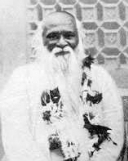Bhaurao Patil facts for kids
Quick facts for kids
Karmaveer
Bhaurao Patil
|
|
|---|---|

Patil in 1949
|
|
| Born | 22 September 1887 |
| Died | 9 May 1959 (aged 71) |
| Occupation | Educationalist, social activist |
| Organization | Rayat Education Society |
| Known for | Spreading education in the rural areas of Maharashtra |
| Awards | Padma Bhushan (1959) |
Bhaurao Patil (born September 22, 1887 – died May 9, 1959) was a famous social worker and teacher in Maharashtra, India. He strongly believed that everyone should get an education. Because of this, he started the Rayat Education Society.
Bhaurao helped many people from less privileged backgrounds and those with low incomes get an education. He taught them the idea of "earn and learn." This meant students could work to pay for their studies. He was also an important member of the Satyashodhak Samaj, a group started by Mahatma Jyotirao Phule that worked for social equality. People in Maharashtra called him Karmaveer, which means "King of actions." The Government of India also honored him with the Padma Bhushan award in 1959.
Contents
Early Life of Karmaveer Bhaurao Patil
Karmaveer Bhaurao Patil was born into a farming family in Kumbhoj, a village in the Kolhapur area. His family followed the Jain religion. His father worked as a clerk for the government. Bhaurao was one of the first Jains in his area to finish the 8th grade of secondary school.
When he was a child, Bhaurao was greatly inspired by Chhatrapati Shahu. Shahu was the ruler of Kolhapur State. He even allowed Bhaurao to live and study in his palace. Shahu believed strongly in social equality and wanted everyone, especially those from backward communities, to get an education.
Later, Bhaurao's father sent him to Kolhapur for more schooling. There, he learned about the Satya Shodhak Movement. He also found inspiration from other great leaders like Mahatma Phule and Maharshi Vitthal Ramji Shinde.
Bhaurao's Social Work
Bhaurao became interested in politics and decided to help India's freedom struggle. He chose to do this by focusing on public education. He worked for companies like Ogale glassworks and Kirloskars. At the same time, he actively joined in the work of the Satya Shodhak Samaj.
He soon realized that the best way to fix social problems was to educate everyone. In 1919, he opened a hostel. This hostel allowed children from lower castes and poor families to live there and study. They could also work to help pay for their expenses. This hostel was the beginning of what later became the Rayat Shikshan Sanstha.
Around the same time, Mahatma Gandhi started his movement for India's independence. In 1921, Bhaurao met Gandhiji in Mumbai. He was very impressed by Gandhi's simple clothes and his ideas of Khadi (homespun cloth). After this meeting, Bhaurao decided to wear Khadi clothes and follow Gandhi's principles in his daily life. He even promised to open 101 schools in Gandhi's name.
However, Gandhiji and Bhaurao had different ideas about accepting money from the government for schools after India became independent. Gandhiji thought that taking government money might lead to rules and control later on. Bhaurao, however, did not see a problem with accepting grants from the government. A book about Bhaurao's life, called The Bountiful Banyan Tree, was written by Pandurang Ganapati Patil.
Rayat Education Society
While working at the Kirloskar factory in Kolhapur, Bhaurao started working for the Satyashodhak Samaj. During a meeting of the Satyashodhak Samaj, a decision was made. To make the Satyashodhak movement successful, it was important to educate the Bahujan Samaj, which means the common people.
So, Bhaurao Patil started the Rayat Shikshan Sanstha on October 4, 1919. He began this society in a small village called Kale, near Karad. The society focused on educating children from all walks of life. That is why it was named Rayat, which is the Marathi word for "masses" or "common people."
During Bhaurao's lifetime, the Sanstha grew a lot. It created 38 boarding schools that welcomed students from all backgrounds. It also started 578 volunteer schools, six training colleges, 108 secondary schools, and three colleges.
Awards and Recognition
- The people of Maharashtra gave him the special title, "Karmveer." This means "King of actions" in Marathi.
- The Government of India honored him with the Padma Bhushan award in 1959. This is a very high civilian award.
- The University of Pune also gave him an honorary D.Litt degree in education in the same year.
- The Karmveer Bhaurao Patil Samaj Seva Puraskar awards are named after him. These awards are given by the Dakshin Bharat Jain Sabha. They recognize people who do important work for education and community service.
- Many people also lovingly called him Anna, which means "big brother."

